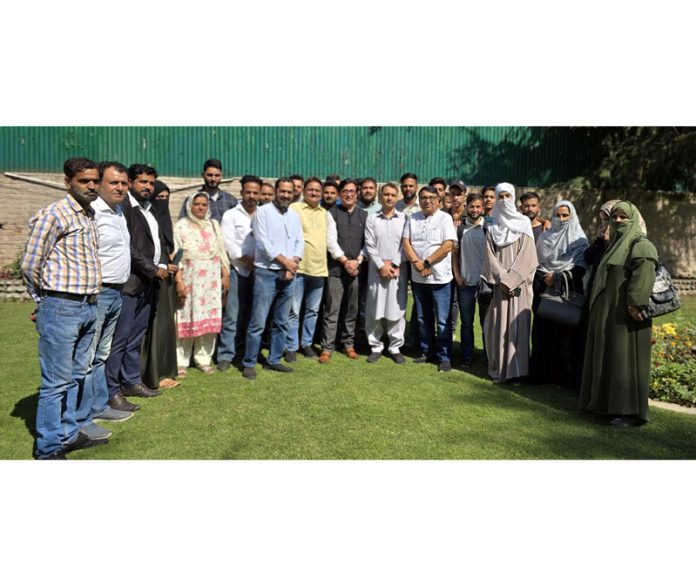GRAND FORKS – It was chilly for an August morning, and a few raindrops fell lazily from the overcast sky and carved divots in the soil, but the grade school students crouched in the dirt around the Winship Elementary sign paid little mind. Watched over and assisted by a handful of teachers and parents, the kids dug holes in the soil and filled them with black-eyed Susans; a clump of lean stems that sprouted purple flowers at their tips; a patch of tall grass; a set of leafy stalks with baby sunflowers blooming at the ends. Megan Baker, a Winship teacher, coaxed students over and supplied them with gardening gloves and tools.
ADVERTISEMENT “Anytime you can get hands-on learning like this, they’re excited,” said Baker. Winship teachers including Baker plan to use the garden, which has been replanted entirely with plants indigenous to North Dakota, in their curriculum this academic year. It’s one of several efforts to reintroduce residents to the native flora that grew freely on the prairie generations ago – and to the medical and holistic purposes these plants have and continue to serve among Native Americans.

The Ojibwe people boiled the tall grass in the Winship garden – little bluestem – to address stomach aches and gas. The Omahas used it in a wash to relieve fever. Black-eyed Susans, known scientifically as rudbeckia hirta, could be used as an immune stimulant, and was made into teas and washes for a broad array of ailments, while sunflower was made into a tea for lung ailments, malaria, and high fevers, or into a poultice to treat snake and spider bites.
The garden “is indigenous to our area and also to the people that use them,” said Jennifer Compeau, who helped co-write the Longest Table grant that brought or will bring gardens like the Winship project to Skidmore Park, the Jay-Cees Park and a couple other locations in Grand Forks. (The Winship garden was paid for by a separate grant received by University Park Neighborhoods.) ADVERTISEMENT A descendant of the Turtle Mountain Band whose husband and children are tribal members, Compeau said she became interested in the garden project as a way to reconnect with that part of her identity.
She said she was pleased to find a group of community members similarly engaged in restoring more of the prairie plants to the community. “It’s been a great learning experience,” she said. “I could have never imagined so many people were already on the same page.
” Compeau didn’t grow up on a reservation, but she did have an uncle living in Grand Forks who kept his own garden of indigenous plants that bloom behind his trailer park home. Her uncle would braid sweetgrass and make bundles of sage, both of which are burned in a purifying ritual called smudging. Her uncle is still alive, but he's older and can’t tend to his garden as much as he did before.
Watching him age has driven her interest in creating spaces where indigenous plants can bloom and people can learn about them. ADVERTISEMENT “That’s part of where the fire came from for me, that these practices aren’t being passed down and I don’t want them to be lost,” she said. Courtney Davis, a tribal research liaison in UND’s Department of Indigenous Health, also uses sage and sweetgrass, as well as cedar and tobacco, for smudging.
Davis likes to bring Native students to the Soaring Eagle Prairie Garden, an installation on UND’s quad where indigenous prairie blooms under a welded rebar sculpture south of the Chester Fritz Library. “As a Native person living in an urban area and not on the reservation, it's about having access to harvest medicine,” said Davis, who also reconnected with Native culture as an adult. UND’s garden is more than two decades old, having been established by the late sociology professor Glinda Crawford in 2002.
Davis, who attended the opening of Skidmore Park’s indigenous garden earlier this summer, was pleased to see more space in Grand Forks featuring the native prairie. “I think it's had that ripple effect with these gardens that are popping up all over, recognizing that there’s this need for access and need for education,” Davis said. “And then there’s that component of highlighting the beauty of the North Dakota prairie, these things that were growing wild at one point across North Dakota.
“ ADVERTISEMENT Teachers at Winship want to use the garden to teach subjects like history as well as soft skills like communication. Baker, who teaches social studies, said she plans to have students come out to weed, water and maintain the garden during the year. Winship’s social studies curriculum includes talking about the history of local Native tribes, and she also wants to have older students do projects on specific plants.
Chrissy Dewey, a multilingual teacher, wants to have her students research the plants to make informational signs about them and present their findings to other students. (Several of the students at August’s planting event were part of the multilingual program.) Speaking in front of others helps build her students’ vocabulary and language skills, as well as their confidence, Dewey said.
Also, she thinks learning about Native culture is particularly resonant at a school where students speak as many as 24 languages. “Our school is just a wealth of diversity of different cultures, and any time we can bring in another culture or learn about the people around us is huge at our school,” she said. ADVERTISEMENT Growing the prairie Over in Sertoma Park, on the east side of the bridge over the English Coulee, lies a plot that blooms with brilliant yellow solidago and patches of purple beebalm and anise hyssop.
Like the Winship garden, Grand Fork Park District landscape supervisor Katy Cavanaugh said, these plants also held medicinal or holistic value: several of the plants now in the Winship garden had hailed from the park district’s nursery, supplied by Cavanaugh, who co-wrote the Longest Table grant with Compeau and UPN’s Renee Carderelle. In addition to their significance to Native culture, the native prairie is an ecological wonder compared to the rest of Sertoma Park’s green lawns. The indigenous plants help propagate insects and pollinators, like bees, Cavanaugh said.
They improve soil health. Next year, when the plot blooms again, a bright new shade will dominate the plot, because of how the soil composition has changed. “Native plants are great,” Cavanaugh said.
“They’re good for the soil, and good for the people.” Over the next few years, Cavanaugh is hoping to expand the prairie plot east into Sertoma Park, adding plant life native to all four corners of the state. On a Wednesday morning at Sertoma Park, in late July, Tom Twedell led a crowd of grade schoolers over the coulee bridge and to the plot, instructing them to study the plants and sketch them on notepads.
ADVERTISEMENT Twedell, a science teacher at Schroeder Middle School, installed some native prairie early on along the banks of the coulee while working as a horticulturist for the park district a few years ago. He’s hoping one day he can bring some of his middle school students out to Sertoma Park to study the prairie, like the field biology class he took as a high school student at Red River. “That was the point when I put all this out there, to turn it into an outdoor classroom,” he said.
“Also,” he added, “I just really didn’t like the grass here.”.



















